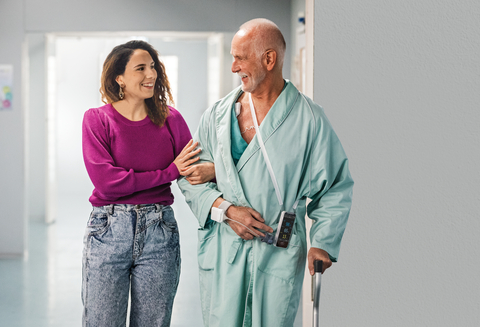GE Healthcare Introduces Wireless Patient Monitoring Solution to Help Clinicians Detect Early Patient Deterioration
GE Healthcare unveiled Portrait Mobile, a wireless patient monitoring system that allows continuous monitoring during hospital stays. This technology aims to detect patient deterioration earlier than traditional methods, potentially reducing ICU admissions and length of stay. The system captures vital signs wirelessly, enabling better patient mobility and early intervention for complications. Developed at GE's center in Helsinki, Portrait Mobile ensures reliable monitoring, leveraging existing hospital networks and improving overall patient outcomes.
- Continuous monitoring may reduce ICU admissions and length of stay.
- Improved patient mobility leads to better recovery outcomes.
- Harnesses existing hospital network infrastructure, minimizing costs.
- None.
Insights
Analyzing...
- Continuous monitoring using wearable sensors in general hospital wards may help detect patient deterioration earlier than traditional spot check methods and assist clinicians in improving patient outcomes1.
- Wireless monitoring allows earlier patient mobilization, a key indicator for recovery, particularly post-surgery2.
-
This innovative technology was developed at GE Healthcare’s global center of excellence for monitoring solutions in
Helsinki, Finland .

Portrait Mobile (Photo: Business Wire)
Globally, an estimated 65 percent of hospital patients and over 90 percent of post-acute care patients are monitored manually and not continually.5 Many vital sign changes are missed during spot checks which often occur in four-to-six-hour intervals6. A
With Portrait Mobile, respiration rate, oxygen saturation and pulse rate for general ward and post-surgery patients can be captured wirelessly, continuously. This innovation allows caregivers to identify changes that may signal that cardiorespiratory complications or infectious disease may be developing. It gives clinicians the opportunity to act early and potentially avert serious adverse events.
“In an evaluation clinical study conducted at a
For patients, Portrait Mobile’s wireless continuous monitoring helps with the ability to move about the hospital, without being restricted to the bedside. This also allows visitors to interact with the patient without technology getting in the way. Moreover, the solution provides patients and family members peace of mind knowing that monitoring is constant - even when the patient is out of their room. Patient mobility may help improve patient outcomes and reduce length of stay, which may lower costs and elevate patient satisfaction10.
Portrait Mobile is designed to be as reliable as wired technology. Its routable communications architecture enables hospitals to leverage their existing network infrastructure when deploying the system, reducing installation and maintenance costs.
Portrait Mobile was developed in
About
Follow us on Facebook, LinkedIn, Twitter, Instagram and Insights for the latest news, or visit our website www.gehealthcare.com for more information.
_______________________
1 Taenzer, et al., Postoperative Monitoring—The Dartmouth Experience.
2 https://www.medelahealthcare.com/en-GB/insights/benefits-of-early-patient-mobilization
3 Portrait Mobile is a CE-marked medical device. Portrait Mobile is not 510(k) cleared and not available in all markets.
4 Brown, et al., Continuous Monitoring in an Inpatient Medical-Surgical Unit: A Controlled Clinical Trial.
5 https://www.managedhealthcareexecutive.com/view/need-continuous-monitoring-todays-healthcare-system
6 Michard, et al., Protecting ward patients. ICU Management & Practice; Vol 19 – Issue 1 (2019).
7 Nolan JP, Soar J, Smith GB, et al. (2014) Incidence and outcome of in-hospital cardiac arrest in the
8 Churpek MM, Yuen TC, Huber MT, et al. (2012) Predicting cardiac arrest on the wards. A nested case-control study. Chest, 141:1170-1176.
9 Loughlin, et al., Respiratory Rate: The Forgotten Vital Sign – Make It Count! Jt Comm J Qual Patient Saf; 44(8) 494-499 (2018).
10 Vincent, et al., Improving detection of patient deterioration in the general hospital ward environment. Eur J Anaesthesiol; 35:325-333 (2018).
View source version on businesswire.com: https://www.businesswire.com/news/home/20220616005149/en/
Media:
pernilla.mello@ge.com
+44 7766 440153
Source:







